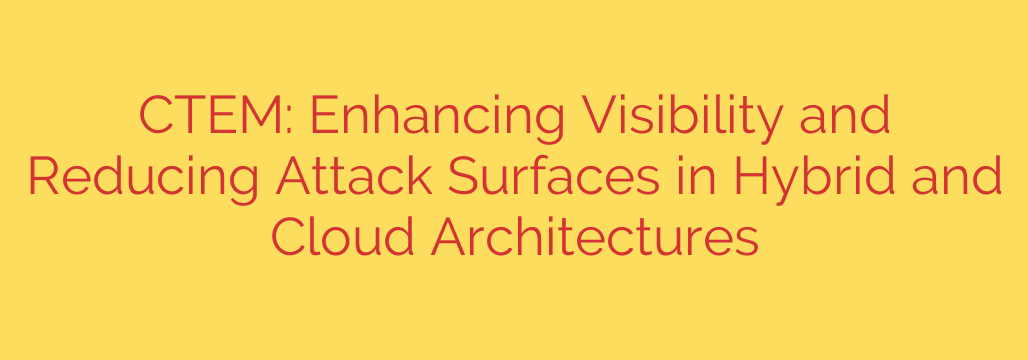
What is CTEM? A Guide to Continuous Threat Exposure Management
In today’s complex IT landscape, security teams are facing an unprecedented challenge. The shift to hybrid and multi-cloud architectures has dissolved the traditional network perimeter, creating a sprawling and dynamic attack surface. Managing this environment with legacy tools often leads to siloed data, overwhelming alert fatigue, and a reactive security posture that leaves organizations perpetually one step behind attackers.
The core problem is a lack of visibility. Without a unified view of all assets and their associated vulnerabilities, it’s impossible to understand, prioritize, and mitigate true business risk. This is where a modern, proactive strategy becomes essential. Continuous Threat Exposure Management (CTEM) is an integrated approach designed to help organizations continuously identify, prioritize, and validate their security exposures.
Beyond Traditional Vulnerability Scanning
For years, organizations have relied on annual penetration tests and periodic vulnerability scans. While valuable, these methods provide only a point-in-time snapshot of a constantly changing environment. They often fail to account for the business context of an asset, leading to a critical question: which of these thousands of vulnerabilities actually matter?
CTEM moves beyond this reactive cycle. It’s not just about finding vulnerabilities; it’s about understanding your entire attack surface from an adversary’s perspective. By correlating assets, vulnerabilities, and active threats, a CTEM program provides the context needed to focus on the exposures that pose the greatest risk to your most critical operations.
The Five Stages of a Successful CTEM Program
CTEM is a cyclical process that provides a structured framework for reducing your attack surface. It consists of five distinct but interconnected stages that work together to build a more resilient security posture.
1. Scoping: The first step is to define what matters most. Instead of trying to protect everything equally, scoping focuses on identifying business-critical assets and high-value systems. This stage involves collaborating with business leaders to understand which processes and data are essential for the organization’s survival and success. This business-centric view ensures that security efforts are aligned with strategic objectives.
2. Discovery: Once you know what’s important, you need to find where it is. The discovery stage involves building a comprehensive and continuously updated inventory of all your assets, both internal and external-facing. This includes everything from servers and databases in your data center to cloud instances, SaaS applications, and code repositories. The goal is to eliminate blind spots and create a single source of truth for your entire digital footprint.
3. Prioritization: This is where CTEM truly shines. With a complete inventory of assets and their known vulnerabilities, the prioritization stage enriches this data with threat intelligence and business context. Instead of just relying on a CVSS score, you can ask more intelligent questions: Is this vulnerability actively being exploited in the wild? Does it exist on a server that houses critical customer data? This allows teams to focus remediation efforts on the most significant risks, rather than chasing down every low-impact flaw.
4. Validation: How do you know if a potential exposure is actually exploitable in your environment? The validation stage uses automated tools and simulated attack paths to test and confirm the real-world risk of a prioritized vulnerability. This crucial step helps security teams separate theoretical risks from practical threats, preventing wasted effort on issues that pose no immediate danger. It answers the question, “Could an attacker really use this to harm us?”
5. Mobilization: The final stage is about action. With a validated, prioritized list of critical exposures, security and IT teams can work together to implement fixes. The mobilization stage focuses on streamlining communication and remediation workflows. By providing clear data and context to the relevant teams, CTEM ensures that fixes are deployed quickly and effectively, with progress tracked to ensure the risk is truly neutralized. This creates a feedback loop that informs the next cycle of scoping and discovery.
Key Benefits of Adopting Continuous Threat Exposure Management
Implementing a CTEM program offers significant advantages over traditional security approaches:
- Reduced Attack Surface: By continuously discovering and remediating exposures on your most critical assets, you proactively shrink the number of opportunities available to attackers.
- Enhanced Visibility and Context: CTEM breaks down data silos, providing a unified view of your security posture that connects technical vulnerabilities to tangible business risks.
- Efficient Remediation: Security teams can stop wasting time on low-priority alerts and focus their limited resources on the threats that matter most, significantly improving operational efficiency.
- Informed Decision-Making: With clear, contextualized data, CISOs and security leaders can more effectively communicate risk to executives and the board, justifying security investments and demonstrating program value.
Actionable Tips for Getting Started with CTEM
Transitioning to a CTEM model is a strategic journey, not an overnight switch. Here are a few practical steps to begin building a more proactive security program:
- Start with Your Crown Jewels: Begin the scoping process by identifying your most critical business applications and data stores. Focus your initial discovery and prioritization efforts here.
- Unify Your Discovery Tools: Work toward integrating the outputs of your various scanners and asset management systems into a single, cohesive view of your attack surface.
- Prioritize with Threat Intelligence: Don’t just rely on vulnerability scores. Integrate real-time threat intelligence feeds to understand which vulnerabilities are being actively targeted by threat actors.
- Automate Validation: Use Attack Surface Management (ASM) and Breach and Attack Simulation (BAS) tools to automatically and safely validate which exposures are genuinely exploitable.
- Foster Collaboration: Build strong communication channels between security, IT operations, and development teams to ensure a smooth and efficient remediation process.
Ultimately, Continuous Threat Exposure Management represents a fundamental shift in cybersecurity—from a reactive, defensive crouch to a proactive, intelligence-driven strategy. By understanding your exposures through the eyes of an attacker, you can find and fix your most dangerous security gaps before they are ever exploited.
Source: https://securityaffairs.com/180871/security/how-ctem-boosts-visibility-and-shrinks-attack-surfaces-in-hybrid-and-cloud-environments.html








